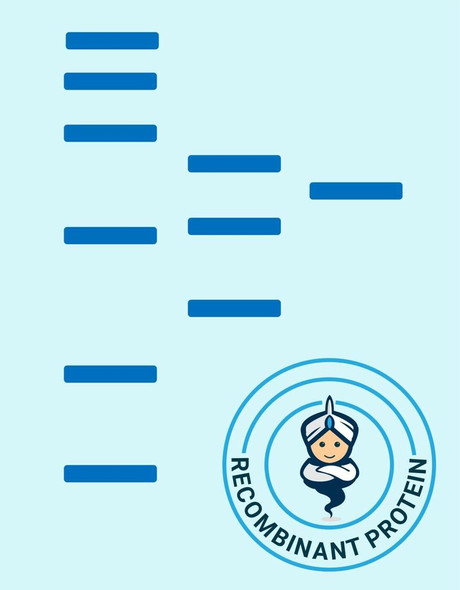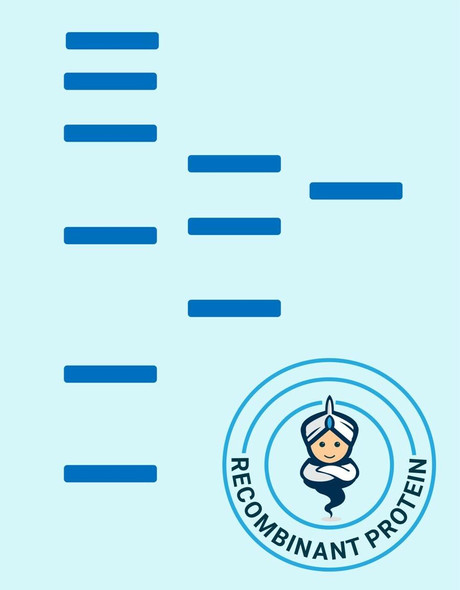Description
| Product Name: | Human EXOSC1 Recombinant Protein |
| Product Code: | RPPB3473 |
| Size: | 10µg |
| Species: | Human |
| Target: | EXOSC1 |
| Synonyms: | Exosome component 1, CGI-108, CSL4, Csl4p, hCsl4p, p13, RP11-452K12.9, SKI4, Ski4p, Exosome complex component CSL4, Exosome component 1, EXOSC1. |
| Source: | Escherichia Coli |
| Physical Appearance: | Sterile Filtered colorless solution. |
| Formulation: | EXOSC1 protein solution (0.25mg/ml) containing 20mM Tris-HCl buffer (pH 8.0), 0.15M NaCl, 20% glycerol and 1mM DTT. |
| Stability: | Store at 4°C if entire vial will be used within 2-4 weeks. Store, frozen at -20°C for longer periods of time. For long term storage it is recommended to add a carrier protein (0.1% HSA or BSA).Avoid multiple freeze-thaw cycles. |
| Purity: | Greater than 90.0% as determined by SDS-PAGE. |
| Amino Acid Sequence: | MGSSHHHHHH SSGLVPRGSH MGSMAPPVRY CIPGERLCNL EEGSPGSGTY TRHGYIFSSL AGCLMKSSEN GALPVVSVVR ETESQLLPDV GAIVTCKVSS INSRFAKVHI LYVGSMPLKN SFRGTIRKED VRATEKDKVE IYKSFRPGDI VLAKVISLGD AQSNYLLTTA ENELGVVVAH SESGIQMVPI SWCEMQCPKT HTKEFRKVAR VQPEFLQT |
EXOSC1 is a non-catalytic component of the exosome which has 3'->5' exoribonuclease activity and participates in many cellular RNA processing and degradation occasions. EXOSC1 associates with the exosome by protein-protein interactions with ribosomal RNA-processing protein 42 and ribosomal RNA-processing protein 46.
EXOSC1 Human Recombinant produced in E.Coli is a single, non-glycosylated polypeptide chain containing 218 amino acids (1-195a.a) and having a molecular mass of 23.8kDa. EXOSC1 is fused to a 23 amino acid His-tag at N-terminus & purified by proprietary chromatographic techniques.
| UniProt Protein Function: | EXOSC1: Non-catalytic component of the RNA exosome complex which has 3'->5' exoribonuclease activity and participates in a multitude of cellular RNA processing and degradation events. In the nucleus, the RNA exosome complex is involved in proper maturation of stable RNA species such as rRNA, snRNA and snoRNA, in the elimination of RNA processing by-products and non-coding 'pervasive' transcripts, such as antisense RNA species and promoter-upstream transcripts (PROMPTs), and of mRNAs with processing defects, thereby limiting or excluding their export to the cytoplasm. The RNA exosome may be involved in Ig class switch recombination (CSR) and/or Ig variable region somatic hypermutation (SHM) by targeting AICDA deamination activity to transcribed dsDNA substrates. In the cytoplasm, the RNA exosome complex is involved in general mRNA turnover and specifically degrades inherently unstable mRNAs containing AU-rich elements (AREs) within their 3' untranslated regions, and in RNA surveillance pathways, preventing translation of aberrant mRNAs. It seems to be involved in degradation of histone mRNA. The catalytic inactive RNA exosome core complex of 9 subunits (Exo-9) is proposed to play a pivotal role in the binding and presentation of RNA for ribonucleolysis, and to serve as a scaffold for the association with catalytic subunits and accessory proteins or complexes. EXOSC1 as peripheral part of the Exo-9 complex stabilizes the hexameric ring of RNase PH-domain subunits through contacts with EXOSC6 and EXOSC8. |
| UniProt Protein Details: | Protein type:Nucleolus; RNA-binding; EC 3.1.13.-; Ribonuclease Chromosomal Location of Human Ortholog: 10q24 Cellular Component: nucleoplasm; cytoplasm; nucleolus; exosome (RNase complex); cytosol; nucleus; nuclear exosome (RNase complex) Molecular Function:protein binding; exoribonuclease activity; RNA binding Biological Process: gene expression; rRNA processing; mRNA catabolic process, deadenylation-dependent decay |
| NCBI Summary: | This gene encodes a core component of the exosome. The mammalian exosome is required for rapid degradation of AU rich element-containing RNAs but not for poly(A) shortening. The association of this protein with the exosome is mediated by protein-protein interactions with ribosomal RNA-processing protein 42 and ribosomal RNA-processing protein 46. [provided by RefSeq, Jul 2008] |
| UniProt Code: | Q9Y3B2 |
| NCBI GenInfo Identifier: | 14285410 |
| NCBI Gene ID: | 51013 |
| NCBI Accession: | Q9Y3B2.1 |
| UniProt Secondary Accession: | Q9Y3B2,Q5JTH3, B2R9B3, |
| UniProt Related Accession: | Q9Y3B2 |
| Molecular Weight: | 21,452 Da |
| NCBI Full Name: | Exosome complex component CSL4 |
| NCBI Synonym Full Names: | exosome component 1 |
| NCBI Official Symbol: | EXOSC1�� |
| NCBI Official Synonym Symbols: | p13; CSL4; SKI4; Csl4p; Ski4p; hCsl4p; CGI-108�� |
| NCBI Protein Information: | exosome complex component CSL4; 3'-5' exoribonuclease CSL4 homolog; CSL4 exosomal core protein homolog; exosomal core protein CSL4; homolog of yeast exosomal core protein CSL4 |
| UniProt Protein Name: | Exosome complex component CSL4 |
| UniProt Synonym Protein Names: | Exosome component 1 |
| UniProt Gene Name: | EXOSC1�� |
| UniProt Entry Name: | EXOS1_HUMAN |






